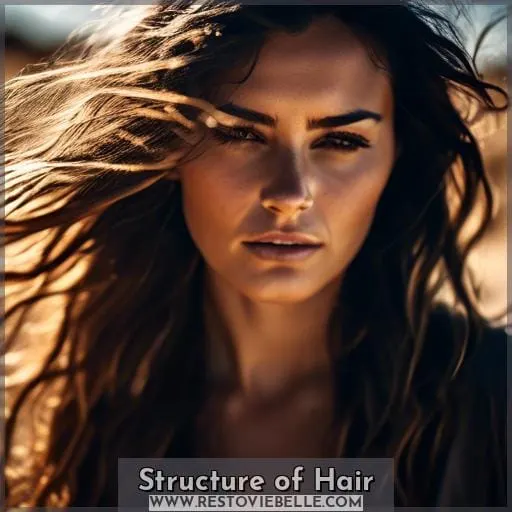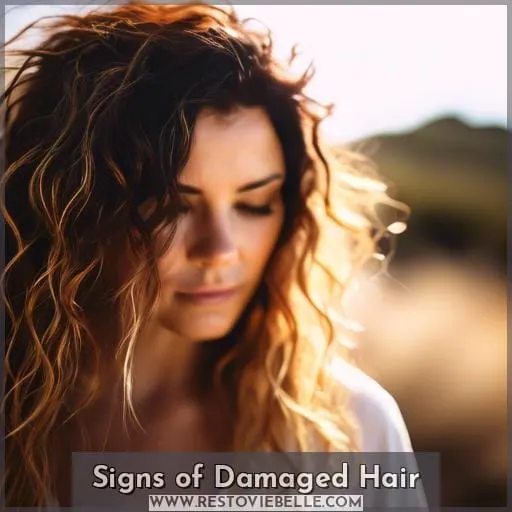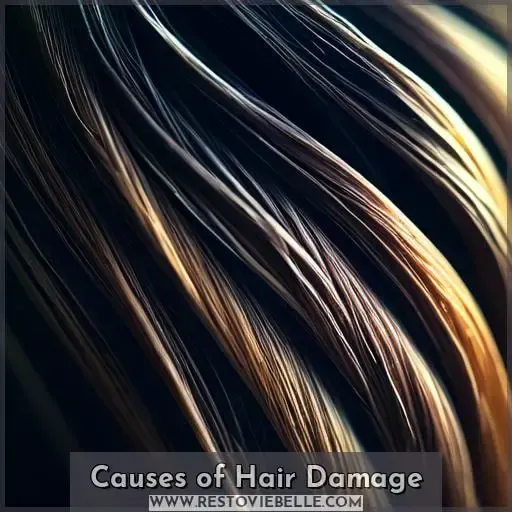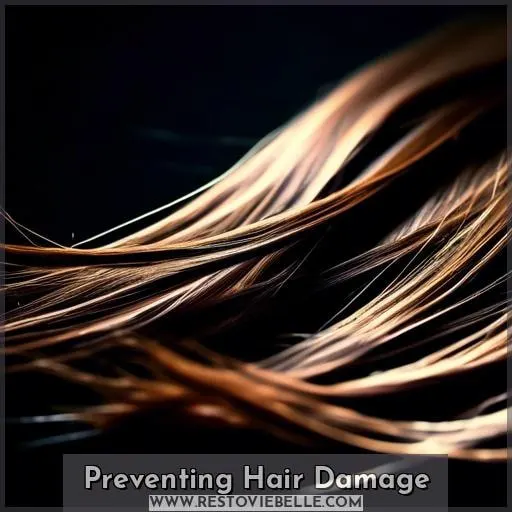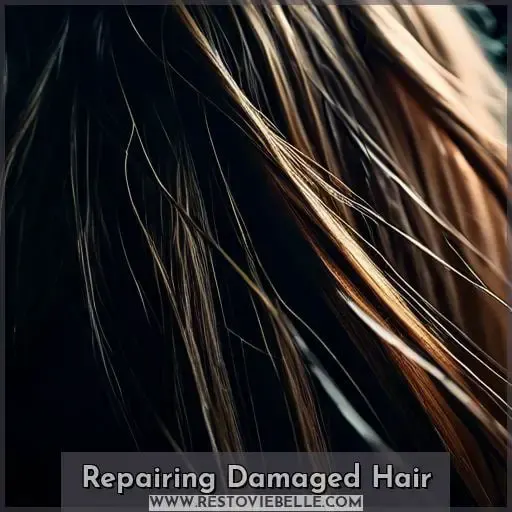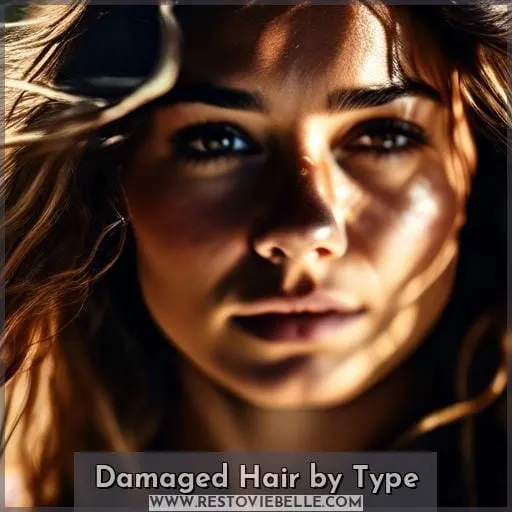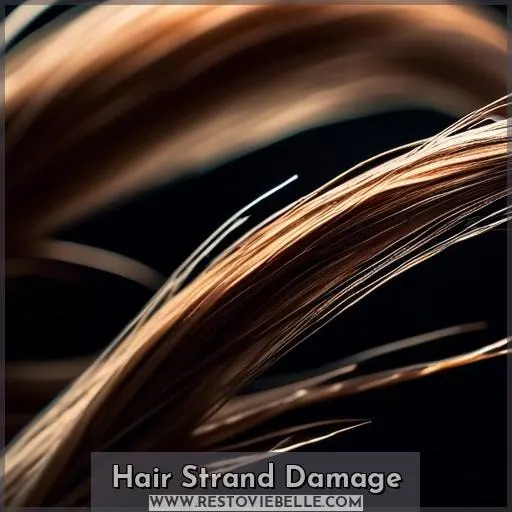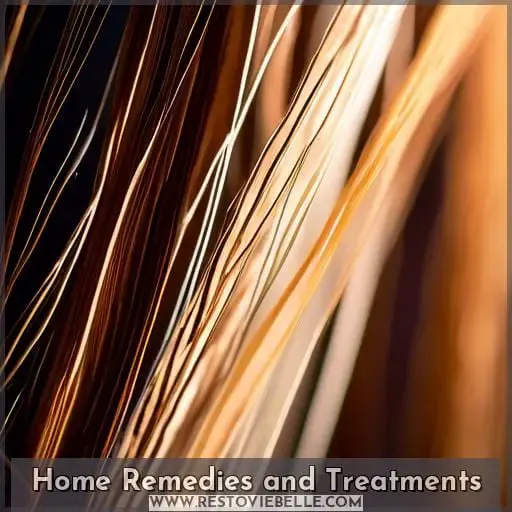This site is supported by our readers. We may earn a commission, at no cost to you, if you purchase through links.
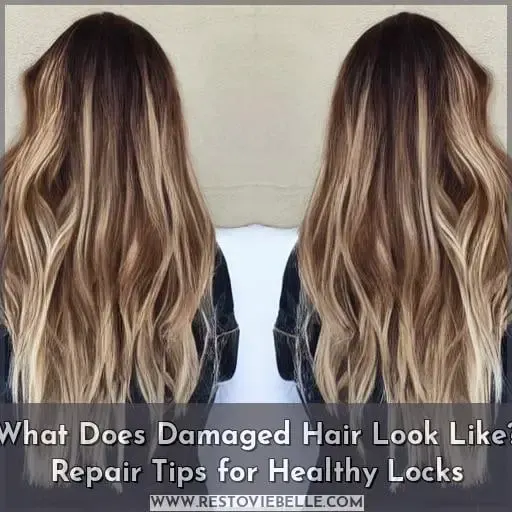 As the saying goes, A stitch in time saves nine, and the same can be applied to recognizing what damaged hair looks like.
As the saying goes, A stitch in time saves nine, and the same can be applied to recognizing what damaged hair looks like.
From split ends to a lackluster sheen, we’ll guide you through identifying the signs of hair damage and arm you with expert tips to repair and rejuvenate your mane.
Embrace the journey to healthier hair, where understanding and care lead to a sense of safety and belonging.
No, damaged hair cannot simply be identified by a single characteristic; it exhibits multiple signs such as looking and feeling dry, brittle, prone to breakage, and lacking natural shine.
Table Of Contents
- Key Takeaways
- Structure of Hair
- Signs of Damaged Hair
- Causes of Hair Damage
- Preventing Hair Damage
- Repairing Damaged Hair
- Damaged Hair by Type
- Hair Strand Damage
- Specific Damage Types
- Home Remedies and Treatments
- Frequently Asked Questions (FAQs)
- How does diet impact hair health, and what specific nutrients are vital for repairing damaged hair?
- Can stress contribute to hair damage, and if so, how?
- What role does the scalp’s health play in preventing and repairing hair damage?
- How does the environment (e.g., pollution, humidity) affect hair health, and what protective measures can be taken?
- Are there any genetic factors that predispose individuals to more hair damage, and how can they mitigate these effects?
- Conclusion
Key Takeaways
- Dry and Brittle Texture: Damaged hair often feels dry to the touch and may appear brittle, indicating a lack of natural moisture and shine. This condition makes hair more difficult to style and can lead to further damage such as breakage, split ends, and dullness.
- Prone to Breakage and Excess Shedding: Hair that easily snaps or sheds more than usual can be a sign of damage. This is often due to weakened hair strands from factors like heat damage, chemical treatments, or physical stressors.
- Dullness and Loss of Luster: When hair loses its natural shine and appears dull, it’s often a sign of damage. Dullness can result from lifted cuticles, which fail to reflect light effectively. This condition can also be accompanied by brassiness or color fading.
- Tangles and Lack of Elasticity: Damaged hair may become more prone to tangles and knots due to lifted cuticles and a rough hair texture. Additionally, a lack of elasticity indicates a moisture imbalance, making hair less able to return to its original shape without breaking.
Structure of Hair
Understanding the structure of your hair is crucial when addressing damage and seeking ways to restore its health.
The cortex, rich in keratin protein and lipids, is the core strength of your hair, determining its resilience and elasticity.
The cell membrane complex plays a pivotal role in hydration and protecting the cortex, while the cuticle’s flat scales shield the hair shaft from external harm.
If you have a medulla, it’s mostly air and some cortex cells, present in certain hair types, adding to the complexity of hair’s structure.
Cortex and Its Role
While you may be familiar with the visible signs of hair damage, such as split ends and dullness, it’s the cortex within your hair strands that plays a crucial role in maintaining overall hair health and integrity.
This inner layer, rich in keratin protein and lipids, determines your hair’s strength and elasticity. Damage here can lead to brittleness, necessitating targeted hair repair treatments.
Importance of the Cell Membrane Complex
The cell membrane complex plays a crucial role in maintaining your hair’s structural integrity by acting as a glue that holds the hair cells together. It’s essential for hydration, leveraging lipids to combat dryness and brittleness.
Genetic factors and external stressors like oxidation can weaken this vital bond, leading to a dull appearance.
Proper hair treatment can reinforce these hair bonds, promoting hair health.
Cuticle Protection
Shield your hair’s cortex from damage by maintaining a healthy cuticle layer. This layer consists of overlapping cells that act like shingles on a roof to protect the more delicate inner structures of your hair strands.
Ensure cuticle hydration and moisture retention with protective treatments against environmental factors.
A robust cuticle preserves hair hydrophobicity, reducing hair porosity and preventing brittleness and dullness.
Medulla’s Presence
Following the discussion on cuticle protection, you’ll find that the medulla’s presence in your hair’s structure plays a unique role. This innermost layer, present mainly in thicker hair types, consists of a soft, thin core filled with transparent cells and air spaces.
Medulla variability affects hair porosity and breakage. Its air space function and transparent cell role are crucial for hair treatment strategies.
Signs of Damaged Hair
Recognizing the signs of damaged hair is crucial for taking the right steps towards healthier locks. If you’re noticing increased frizziness, it could be a sign of high porosity, which means your hair absorbs moisture quickly but also loses it just as fast.
Tangles and knots may develop more frequently when the cuticles are lifted, making your strands prone to snagging on each other.
A lack of elasticity indicates your hair is thirsty for moisture, and without it, your hair becomes less able to return to its original shape after being stretched. Split ends, dullness, and a brittle texture are all indicators that your hair may be suffering from damage and could benefit from some tender loving care.
Frizziness and Porosity
Hair frizz and tangling can be frustrating issues, often caused by high porosity. This condition allows moisture to penetrate the hair shaft quickly, but it also leads to rapid moisture loss.
To address these problems, several methods can be effective. Hydration treatments are essential for restoring moisture balance to the hair.
Regular application of oils can also be beneficial. These help to reinforce the hair cuticle’s ability to repel water, which includes maintaining the important 18-MEA lipid layer.
Tangles and Knots
Hair tangles and knots are telltale signs you’re dealing with damaged locks, requiring a boost of nourishment to restore smoothness.
Perfecting your brushing techniques and using moisturizing oils can significantly improve hair manageability.
Silk pillowcases reduce friction, while protective styles prevent further stress.
Lastly, hydration treatments deeply condition the hair fiber, ensuring your brush glides through with ease.
Lack of Elasticity
Transitioning from the frustration of tangles and knots, you’ll find that a lack of elasticity is another telltale sign of hair in distress. When your locks lose their spring, it’s often due to an imbalance in moisture and protein—key components of hair health.
- Elasticity testing reveals weak, limp strands.
- Moisture balance is off, making hair brittle.
- Protein treatments may improve resilience.
Split Ends
You’ll notice split ends when the tips of your hair begin to fray, resembling the branches of a tree or forming a Y shape. To combat this, consider your trimming frequency and use hair masks to nourish. Hair bond-builders can also reinforce your strands.
| Cause | Solution |
|---|---|
| Hair dryness | Hair masks |
| Hair breakage | Hair trim |
| Styling damage | Hair bond-builder |
| Chemicals | Reduce usage |
| Heat | Protective treatments |
Dullness
A lack of shine indicates your hair’s cuticles are lifted, preventing smoothness and reflectivity that contribute to a healthy appearance.
- Use hydrating masks to combat dryness and enhance shine.
- Trim regularly to prevent split ends and maintain vibrancy.
- Apply natural oils for a glossy finish.
- Rinse with cool water to seal cuticles for vibrant locks.
Dryness
Amidst the struggle with dryness, you’re likely to notice your hair’s texture becoming coarse and wiry, accompanied by an itchy, irritated scalp, all of which signal a desperate need for moisture.
This is where moisturizing techniques and DIY hair masks come into play, offering a beacon of hope.
The effects of humidity can exacerbate hair dryness, making a tailored hair regimen essential, especially during winter dryness.
Scalp hydration is key, as a healthy scalp fosters healthy hair growth.
Incorporating nourishing oils into your routine can combat hair split ends and brittleness, transforming your locks from dull and lifeless to vibrant and elastic.
Breakage and Hair Loss
Following the discussion on dryness, which can make your hair more prone to damage, let’s delve into breakage and hair loss as further signs of compromised hair health. When your hair becomes excessively dry, it’s more likely to snap and shed, leading to noticeable thinning and a lack of fullness.
- Nutrition Impact: A balanced diet supports hair integrity and growth.
- Styling Precautions: Avoid tight hairstyles that strain the scalp and follicles.
- Environmental Influence: Protect your locks from sun and pollution to prevent dry hair and split ends.
Brittle Texture
Often, you’ll notice that damaged hair feels brittle and is more prone to snapping when you try to comb or style it.
Nutrient infusion can transform the texture, while repair techniques like using a hair bond-builder target the core of each follicle.
Causes of Hair Damage
In your quest for luscious locks, it’s crucial to understand that various factors can lead to hair damage. From the harsh rays of the sun to the chemicals in your favorite hair products, these elements can strip your hair of its natural moisture and vitality, leaving it dry, brittle, and lackluster.
Recognizing the culprits behind damaged hair is the first step towards nurturing your strands back to health and preventing further harm.
Pollution and Free Radicals
You’re exposed to pollution and free radicals daily, which can significantly damage your hair by causing oxidative stress.
- Environmental Shield: Use hair products that act as a barrier against urban pollutants.
- Antioxidant Defense: Include treatments with antioxidants to combat free radical damage.
- Pollution Protection: Regular hair trims can remove damaged ends, enhancing hair resistance to breakage.
- Free Radical Fighters: Opt for haircare specifically designed to protect against pollution and free radicals.
Sun, Sweat, and UV Damage
Exposing your hair to the sun and sweat can lead to significant damage, making it crucial to understand the effects and implement protective measures. Sunlight, particularly its ultraviolet (UV) rays, can be as harmful to your hair as it’s to your skin.
UV rays cause the hair cuticle, the outer protective layer, to break down, leading to dryness, brittleness, and fading color. This damage isn’t just superficial; it can also affect the hair’s cortex, leading to weakened strands that are more prone to breakage and loss of elasticity.
Sweat adds another layer of stress on hair health. It can increase hair porosity, making strands more susceptible to tangling and breakage. The moisture from sweat can also lift the hair’s cuticles, leading to further tangling and making the hair feel gummy when wet and straw-like when dry.
To protect your hair from sun and sweat damage, it’s essential to adopt preventive measures. Using products with UV protection, wearing hats or scarves when exposed to direct sunlight, and applying leave-in conditioners or treatments that can shield the hair from UV rays are effective strategies.
Additionally, washing your hair after sweating to remove salt and other residues can help maintain hair health. Using gentle, moisturizing shampoos and conditioners can also aid in restoring hydration and preventing further damage.
In summary, both sun exposure and sweat can significantly damage hair, affecting its strength, texture, and appearance. Understanding these effects is crucial for implementing protective measures to maintain healthy, vibrant hair despite these environmental stressors.
Harsh Chemicals
Harsh chemicals in hair care products, such as sulfates, parabens, and formaldehyde, can strip your hair of its natural oils and lead to damage.
- Free Alternatives: Seek eco-friendly products with gentle formulations that nourish rather than harm.
- Natural Ingredient Solutions: Embrace DIY repair methods using ingredients from your kitchen.
- Hair Repair Tips: Opt for products that promise to increase hair density and diameter without harsh chemicals.
Aging Effects
After discussing the impact of harsh chemicals on hair health, it’s important to note that as time progresses, aging naturally affects your hair’s appearance and structure.
Genetic factors and hormonal changes can lead to thinning, while nutritional deficiencies impact scalp health.
Adopting healthy lifestyle habits, like a balanced hair diet and using nourishing hair oil and detanglers, can mitigate aging effects.
Thermal Damage From Heat Styling
Transitioning from the aging effects on hair, heat styling emerges as another significant culprit behind hair damage.
- Heat Protectant Importance: Shields your strands, maintaining hair smoothness.
- Quality Styling Tools: Prevents bubble hair, preserving hair length.
- Moisture Restoration Techniques: Essential for reversing dryness and brittleness, ensuring your locks stay healthy. Regular professional trims also play a crucial role in keeping damaged hair at bay.
Chemical Treatments
Why do your luscious locks turn dry and brittle after chemical treatments? Chemical Treatments strip your hair’s natural oils, leading to a dull appearance and increased tangles. To combat this, seek Salon Expertise for Repair Techniques and use Protective Measures like nourishing hair shampoo.
| Chemical Treatments | Repair Techniques | Protective Measures |
|---|---|---|
| Bleaching | Deep Conditioning | Nourishing Shampoo |
| Coloring | Protein Treatments | Heat Protectants |
| Perming | Trimming Split Ends | Regular Hydration |
| Relaxing | Leave-in Conditioners | Gentle Detangling |
Preventing Hair Damage
Recognizing the signs of damage in your hair, such as split ends, brittleness, and a lackluster appearance, is the first step toward prevention.
To protect your locks, opt for safe hair dyes and always apply a heat protectant before using styling tools.
Proper hair washing and drying techniques, along with targeted shampoo and conditioner use, can also play a crucial role in maintaining healthy hair.
Choosing Safe Hair Dyes
Continuing from the discussion on the various causes of hair damage, it’s important to consider the impact of hair coloring.
Opt for dyes that match your natural tone to reduce processing time.
Seek professional advice to avoid allergic reactions and understand long-term effects.
Proper application techniques also play a crucial role in maintaining healthy locks.
Using Heat Protectants
Before using any heat styling tools, it’s crucial to apply a heat protectant to shield your hair from potential damage.
By adopting heat shielding techniques, you’re not just styling safely; you’re actively protecting hair strands.
Embrace thermal protection and heat defense strategies to maintain your hair’s health and vibrancy.
Proper Washing and Drying Techniques
While using heat protectants is a crucial step in safeguarding your hair from thermal damage, adopting proper washing and drying techniques is equally essential to prevent hair damage.
- Proper detangling with a wide-tooth comb before washing
- Gentle scalp massage during shampooing
- Coldwater rinse to seal cuticles
- Air-dry benefits over harsh blow-drying
- Moisturizing methods, like leave-in conditioners
Shampoo and Conditioner Application
To prevent hair damage, it’s crucial you apply shampoo directly to your scalp and massage gently, allowing the suds to cleanse your hair as they rinse out, rather than rubbing the shampoo down the length of your hair.
Customizing product usage to your hair type and mastering proper rinsing techniques can make a world of difference. Scalp massage benefits circulation, while water temperature impact and detangling strategies protect your hair’s integrity.
| Step | Tip |
|---|---|
| 1 | Use lukewarm water to open cuticles. |
| 2 | Gently massage scalp to distribute oils. |
| 3 | Cool rinse to seal moisture, add shine. |
| 4 | Detangle with fingers or wide-tooth comb. |
Repairing Damaged Hair
If your hair’s showing signs of split ends, brittleness, or a dull appearance, it’s time to take action. Regular trims can help remove damaged ends. Conditioning treatments restore moisture and strength.
Using gentle detangling methods and nourishing oils can further protect and revitalize your locks.
Regular Trims
Regular trims are essential in preventing split ends and minimizing breakage, helping you maintain healthier hair.
Trimming benefits go beyond just length retention; they pave the way for stylish haircuts and a vibrant appearance.
Whether you opt for salon visits or DIY trimming, keeping your ends fresh reduces brittleness and dullness, ensuring your locks always feel loved and look lively.
Conditioning Treatments
After getting regular trims to remove split ends, you’ll find that incorporating conditioning treatments is another crucial step in repairing damaged hair.
Deep hydration and intensive repair protein infusions offer a moisture boost, transforming your locks to silky smooth with a shine revival.
Make revitalizing masks a weekly ritual.
Explore reconstructive serums or hair elixirs for an extra layer of care.
Gentle Detangling Methods
When detangling damaged hair, opt for a wide-to-oth comb and avoid brushing it while wet.
Detangling wet hair:
- Wet hair is more delicate and prone to breakage.
- Detangle gently when dry.
Detangling dry hair:
- Use a wide-to-oth comb to gently remove tangles.
- Start from the ends and work your way up to the roots.
- Use your fingers to detangle your hair, starting from the ends and working your way up.
- Be gentle and avoid pulling or tugin on your hair, as this can cause further damage.
Limiting Wet Hair Brushing
To prevent further damage, limit brushing wet hair as it’s more prone to snapping and tearing.
- Instead, gently detangle it with a wide-tooth comb or your fingers.
- Avoid tight ponytails and buns when hair is wet.
- Use a silk pillowcase to reduce friction and breakage.
Incorporating Nourishing Oils
Give your damaged hair the nourishment it needs by incorporating nourishing oils into your hair care routine. Natural oils like coconut oil, argan oil, and olive oil are rich in fatty acids and antioxidants that can penetrate the hair shaft and provide deep conditioning.
They help repair split ends, reduce breakage, and restore shine and luster to your hair.
| Oil | Benefit | How to Use |
|---|---|---|
| Coconut Oil | Deeply moisturizes, reduces protein loss, and promotes hair growth | Apply to hair and scalp, leave in for at least 30 minutes, then wash out |
| Argan Oil | Rich in antioxidants and fatty acids, helps repair damage and protect against heat styling | Apply a few drops to damp or dry hair, focusing on the ends |
| Olive Oil | Nourishes and strengthens hair, helps prevent breakage and split ends | Massage into hair and scalp, leave in for at least 30 minutes, then wash out |
Damaged Hair by Type
Your hair’s damage can vary based on your hair type.
If you’re a man, you might notice dryness, brittleness, and dullness.
Curly hair is prone to split ends, frizz, and breakage.
And if you’ve heat-styled your hair, you could have split ends, frizz, and dullness.
Men’s Hair Damage
Your hair can also suffer damage if you’re a man, causing issues such as:
- Dryness
- Brittleness
- Split ends
- Dullness
To combat these concerns, opt for gentle:
- Shampoos
- Conditioners
Avoid harsh styling products and excessive heat. Consider incorporating a hair mask into your routine.
Curly Hair Concerns
Curly hair’s damage manifests as split ends, frizz, breakage, and dullness. It’s a common issue caused by the hair’s natural fragility and lack of moisture.
To combat this, try natural remedies like hair masks and protective styles. Avoid sulfates and opt for gentle scalp treatments to restore health.
With care, you can bring your curls back to life.
Heat Damage Issues
If you’re battling heat damage from styling tools, you’ll notice a significant decrease in hair’s health.
Split ends, brittleness, and dull appearance are all telltale signs of heat damage.
To protect your hair, always use a heat protectant spray before styling.
Avoid using excessive heat and opt for lower heat settings whenever possible.
Additionally, consider incorporating regular deep conditioning treatments into your hair care routine to restore moisture and vitality.
Perm and Relaxer Damage
Next, perm and relaxer treatments can leave your hair dry, brittle, and prone to split ends due to their chemical-altering properties.
Understanding rebonding risks and the importance of neutralizing can safeguard your locks.
Post-treatment care is crucial for recovery.
Regular strand testing before texture alteration ensures your hair’s resilience, maintaining its health and vibrancy amidst these transformative processes.
Hair Strand Damage
If you’re noticing that your hair has lost its luster, feels rough to the touch, or seems to snap easily, it’s likely showing signs of damage.
Brittle strands and split ends are clear indicators that your hair needs some extra care and attention.
To combat these issues, it’s essential to recognize the damage and implement repair strategies to restore your hair’s health and shine.
Identifying Brittle and Dull Strands
Moving on from the various types of hair damage, let’s zero in on identifying brittle and dull strands, which are telltale signs of hair in distress. You’ll recognize brittle hair by its lack of flexibility, leading to breakage and split ends, while dullness is evident when your hair loses its natural shine and appears lifeless.
- Moisturizing Techniques for resilience
- Protein Treatments to strengthen
- Hydration Strategies for vitality
- Repairing Rituals for restoration
- Achieving a Glossy Finish for shine
Recognizing Split Ends and Frizz
Recognizing split ends and frizz in your hair is a clear indication that your strands are in need of some tender loving care.
Split end prevention starts with regular trims.
For frizz control, focus on moisture retention; hydrating products are key.
When styling damaged hair, use gentle techniques and avoid high heat.
These trimming tips and care methods will help maintain your hair’s health.
Specific Damage Types
You might notice your hair’s shine has diminished, leaving it looking lacklustre and lifeless. If your locks feel rough to the touch and break easily, you’re likely seeing the impact of sun or chemical damage.
These symptoms can be a clear sign that your hair needs some tender loving care to restore its health.
Sun Damage Effects
Sun damage can wreak havoc on your hair, leading to dryness, brittleness, and faded color. To shield your locks, consider sunscreen for hair, offering vital UV protection.
Embrace sun-proof styles and seek shade solutions when outdoors.
After exposure, indulge in after-sun care to rejuvenate and repair.
Your hair’s health is paramount, so always prioritize its defense against the sun’s harsh rays.
Chemical Damage Symptoms
After transitioning from the effects of sun exposure, it’s crucial to address another significant cause of hair woes: chemical damage. Chemical treatments, including dyes, relaxers, and perms, can strip your hair of its natural oils and proteins, leading to symptoms like dryness, brittleness, and split ends.
Color change, scalp irritation, texture alteration, allergic reactions, and hair thinning further signal the toll of chemical processes on your locks.
Home Remedies and Treatments
When you’re dealing with damaged hair, it’s crucial to incorporate treatments that can help restore your locks at home.
You might want to start with deep cleansing shampoos that can remove buildup without stripping your hair of its natural oils.
Alongside, consider integrating nourishing home care routines, such as regular deep conditioning treatments, to combat dryness and improve hair health.
Deep Cleansing Shampoos
To effectively remove product buildup and revitalize your hair, consider incorporating a clarifying shampoo into your routine.
- Clarifying Benefits: Boosts shine by stripping away dulling residue.
- Scalp Renewal: Promotes a healthier scalp environment, reducing itchiness.
- Residue Removal: Ensures thorough cleansing, paving the way for purifying rituals that restore hair’s natural vibrancy.
Recommendations for Home Care
For those seeking to rejuvenate their locks at home, incorporating natural oils into your routine can make a significant difference. Try DIY masks and overnight treatments to restore moisture. Don’t neglect scalp care; it’s crucial for healthy growth.
| Treatment Type | Frequency | Key Benefit |
|---|---|---|
| DIY Masks | Weekly | Hydration |
| Overnight Treatments | Bi-weekly | Repair |
| Moisturizing Routines | Daily | Softness |
| Scalp Care | As needed | Health |
Frequently Asked Questions (FAQs)
How does diet impact hair health, and what specific nutrients are vital for repairing damaged hair?
Your diet plays a crucial role in hair health, providing the building blocks for repair.
Key nutrients include protein for keratin, iron to prevent loss, and omega-3s for shine.
Vitamins A, C, E, and B-complex are essential for growth and strength.
Can stress contribute to hair damage, and if so, how?
Like a storm wreaking havoc on a once-calm sea, stress can indeed unleash turmoil on your hair, leading to damage and loss. It stealthily pushes hair follicles into a resting phase, preventing new strands from forming and causing existing ones to fall out more easily.
What role does the scalp’s health play in preventing and repairing hair damage?
A healthy scalp is crucial for preventing hair damage; it nurtures emerging strands, fighting oxidative stress that leads to breakage and dullness.
How does the environment (e.g., pollution, humidity) affect hair health, and what protective measures can be taken?
The environment, including pollution and humidity, can significantly impact hair health. For instance, pollution and UV exposure can lead to increased hair damage, while humidity can cause frizz and increased porosity.
Protective measures such as using shampoos suited for your hair type and minimizing exposure to extreme heat can help mitigate these effects.
A global hair study revealed that 70% of people perceive they have damaged hair, with top concerns being dandruff, hair loss, and greying hair. This statistic highlights the widespread awareness of hair damage, emphasizing the importance of understanding and addressing its causes and effects.
Are there any genetic factors that predispose individuals to more hair damage, and how can they mitigate these effects?
Yes, genetic factors can predispose individuals to more hair damage.
To mitigate these effects, consider treatments like minoxidil or finasteride to slow hair loss.
Adopt a healthy lifestyle with balanced nutrition to support hair health.
Conclusion
Just as a tapestry frays without care, so too can your hair show the wear of life’s challenges.
But fear not, for recognizing what damaged hair looks like is the first step to restoration.
Embrace the journey to revive your mane from dullness and split ends to a vibrant cascade of health.
With the right care, your locks can reclaim their strength and shine, proving that a stitch in time truly does save nine.
